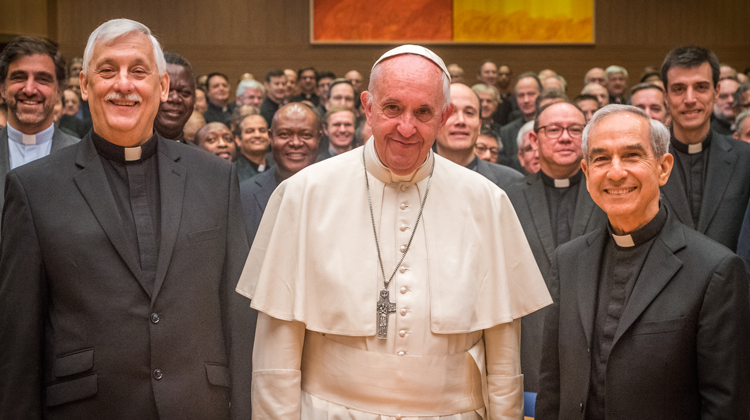Society of Jesus’ July 31 is the feast of St Ignatius of Loyola, Founder of Society of Jesus’

Camil Parkhe
Pune, 31st July 2021: This month, the name of the ‘Society of Jesus’ or ‘Jesuits’, an organization of Catholic clergy, suddenly came to the fore in the Indian and world media. There are indications that the name of this organization will remain also in the discussion due to the agitation started by some organizations in the near future.
The reason for this is that 84-year-old Father Stan Swamy from Jharkhand who was jailed in Jharkhand on charges of ‘terrorism’, ‘urban naxalism’, ‘involvement with Maoist organizations’ and so on, died while awaiting bail from the high court.
Incidentally, Fr. Stan Swamy was a member of the Jesuit organization.
The current Pope Francis, head of the Catholic Church, is the first Jesuit to reach the papacy.
St. Ignatius of Loyola, along with St. Francis Xavier and other associates, founded the Society of Jesus in 1540 and is said to have ushered in the “Age of Reformation” in the Catholic Church.
The feast of St. Ignatius of Loyola (1491-1556) is celebrated on July 31. The festival is widely celebrated in all Jesuit institutions, schools and colleges.
Mortal remains of St. Francis Xavier are still preserved at the Bom Jesu Basilica in Old Goa. The feast of St. Francis Xavier is celebrated on December 3 and draws a large number of devotees to Old Goa . Goa government has declared as public holiday on this day.
The Catholic Church is the largest organization in the world. Its network extends to all over the world. The church reaches out to the grassroots through its diocesan and religious leaders and nuns. There is no other institution in the world with a vast network of contacts and work like the Catholic Church.
The Catholic Church has two types of clergy – Secular and Religious. A diocese priest works in a particular diocese. Diocesan clergies are also called ‘secular clergy’. The head of each diocese is the bishop, and the diocesan clergy work under the jurisdiction of these bishops and within the boundaries of that diocese. Pune diocese, for example, includes Pune, Satara, Solapur, Sangli districts and Kolhapur city.
In addition, the church has religious organizations of religious leaders who carry out various tasks or missions. The members of these Religious organizations are called ‘Religious’ priests . Among them is the Society of Jesus, founded by Ignatius of Loyola. Its members are called ‘Jesuits’
In addition, the Salesians of Don Bosco, an organization of clergy founded by Don Bosco, works primarily in the field of education. Don Bosco schools and colleges are world renowned. The Missionaries of Charity, an organization of nuns founded by Mother Teresa, works for orphans and the elderly.
Normally only the diocesan or secular clergy are appointed bishops. Archbishops and cardinals are the higher posts. The College of Cardinals comprising of around 110 cardinals in the world, elects the new pope whenever there is a vacancy. Religious clergy can also become bishop, and the pope, like the current Pope Francis, if allowed by their religious organizations. Thus the first Bishop of Nashik, Thomas Bhalerao, was a religious- a Jesuit-, while the Bishop of Pune, Thomas Dabre, and the Bishop of Vasai, Felix Machado, are Secular, diocesan clergies. .
The Jesuits have been instrumental in bringing about a renaissance in the Catholic Church. The Jesuit clergy are considered to be very progressive and the pioneers in many fields including education, social work, literature etc. The earth was once thought to be flat and the earth and man were treated as the center of the universe. Scientists in the Middle Ages were skeptical of the Church’s views. Against this background, many may be surprised to know that the Jesuits have made an immense contribution in the field of astronomy.
Mughal emperor Akbar had invited scholars of different religions to his court. These pundits included a team of European Jesuits based in Goa at that time. Rudolf Acquaviva and his companion Jesuits from Goa whichn was then under the Portuguese rile, went to the Mughal court. These Jesuits were the first Europeans and Westerners to attend the Mughal court from 1580 to 1583 and beyond.
The Jesuits were excited that Emperor Akbar was eager to learn about Christianity and hoped that Akbar would convert to Christianity. But Emperor Jalaluddin Akbar disappointed them. The Mughal emperor did discuss with scholars of different religions, but without embracing any of these religions, he established an independent religion called ‘Dine Ilahi’!
Some European nations, such as Portugal, France, and Spain, had banned activities of the Society of Jesus and Jesuits were expelled from these countries. These areas included Goa which was then under Portuguese control. Pope Clement XIV too later issued a decree in 1773 banning the Jesuit congregation. The ban is known as the “Suppression of the Society of Jesus”. Pope Pius VII in 1814 lifted the ban and restored activities of the Society of Jesus.
After completing the secondary education at Shrirampur in Ahmednagar district in Maharashtra, I too joined the Jesuit pre-novitiate to become a Jesuit priest. During that five years of training and in college life in Panjim in Goa, I have experienced firsthand the life, zeal, and dedication of the Jesuits. In a way, I have lived a Jesuit life. Later, I changed my mind about living a Jesuit life, but some friends still remind me of the saying, “Once a Jesuit, always a Jesuit.”
Father Thomas Stephens was the first British Jesuit to set foot in Goa. He learned Marathi language and composed ‘Khristpuran’ epic in Marathi and it was published in 1606. ‘Khristpuran’ is the first book in Marathi language to be printed in Roman script in Goa in the early seventeenth century. When the Portuguese brought printing presses to Goa, it was not possible to print the book in Devanagari script, so it was printed in Roman script.
Prasad Publication’s Y. G. Joshi published Shantaram Bundelu-edited ‘Khristpuran’ in Devanagari script in 1956.
Jesuit Fathers have made a significant contribution to education in India. Xavier School of Management in Jamshedpur, and St. Xavier’s College in Mumbai are some of the leading Jesuit institutions in India. Two well-known schools in Pune, Loyola and St. Vincent’s School, are run by the Jesuit clergy.
De Nobili College at Ramwadi on Ahmednagar Road in Pune is an international organisation run by the Jeesuits. Pope John Paul II visited this institute during his 1986 visit to India.
‘Poverty, celibacy and obedience’ are the three vows a Jesuit takes. No Jesuit can own a own house or property. The process of becoming a Jesuit is very rigorous, one has to complete degree, postgraduate education and study philosophy and theology. The drop out percentage in at formation stage is therefore very high. .
The work of the Jesuits and their missionary zeal have had a profound effect. In the social, political and educational spheres of Maharashtra,
When Mahatma Gandhi’s guru Gopal Krishna Gokhale founded the Servants of India Society, he heavily relied on the constitution of the Society of Jesus for the formation of his organization. In Pune, Lokmanya Bal Gangadhar Tilak and Gopal Ganesh Agarkar set up modern educational institutions, influenced by the missionary work of the Jesuit missionaries.
Lokmanya Tilak’s colleague trustees in his educational institution often had disputes about honorarium, paid services. Lokmanya Tilak insisted that the trustees should serve with a missionary attitude like the Jesuits.
Lokmanya Tilak and Gopal Ganesh Agarkar are often referred to as ‘Indian Jesuits’.
The Jesuits’ way of working, their style of dining together, their vow of celibacy impressed many in India. It is no secret that so many organizations and associations in India have emulated the Jesuits for their work.
The largest number of Jesuit are in the United States, followed by India. Today, many people are working at the forefront in the social, political, educational and health sectors may have been educated at Jesuit institutions. The list of names of such people will be very long.
At the beginning of the 19th century, when the Jesuits opened schools in Sangamner, Songaon, Kendal villages in Ahmednagar district, for the first time, children of untouchable and underprivileged communities were educated together.
The Jesuit clergies used to ring the bell to call the village children to school. Earlier, no one had invited children from these underprivileged sections to attend school.
It is noteworthy that the Jesuit Fr. Harmann Bakher, who is now nearing century in Switzerland, pioneered rural development in the Ahmednagar district of Maharashtra in the 1960s and 70s. The rural development work of Anna Hazare and others followed much later.
Fr. Matthew Lederle, founder of the Snehasadan Inter-religious Dialogue Center in Pune, was also a Jesuit. Snehasadan has made invaluable contributions in many fields of literature, culture, theater, ideology, education in Pune.
The work of the Jesuit clergy has always been pioneering nature. They are always on the lookout for innovation. The huge churches and renowned schools and institutions founded by them are often handed over to the local bishops, the diocesan or secular clergy, and the Jesuits leave for new areas to look for new challenges, to build something new.
Jesuits are involved in many missionary activities, such as education, vocational training, social work, etc., but many of them have never converted nor baptized any adults.
Jesuits and other Catholic clergy, who have worked in many nations for decades, have often sided with those exploited and oppressed community. In Latin America, as well as in many Third World countries, “liberation theology” has been popular among the Catholic clergy.
Fr. Henry Heras, a Spanish clergyman who taught history at Xavier College in Mumbai, is credited for his research in Indology. Fr. Camil Bulke was the a Belgian Jesuit priest to receive the first doctorate in Hindi. He got the doctorate from Allahabad University for his thesis `Ramakatha: Origin and Development.’ Fr. Bulke also compiled an English-Hindi Dictionary.
Robert de Nobili (1597-1656) was a Jesuit who was Sanskrit and Tamil scholar. He is said to have introduced classical Sanskrit literature to the Western world for the first time. The poem ‘Tambovani’, written by Fr. Thomas Beschi (1680-1747), is considered to be one of the most classical works in the Tamil language.
A group of Jesuits led by Fr. Stan Fernandes from Pune had been working under the ‘Jesuit Refugee Service’ to help the local people in Afghanistan. One of them, Kerala’s Jesuit Father Alexis Prem Kumar, was abducted in 2015 and later released through the mediation of the Indian government.
The Jesuit Superior General has an important place in the church because of the large network of Jesuit works around the world. The Jesuit Superior General who wears a black robe before the white-clad pope, has been also called the ‘Black Pope’.
A few years ago, when Jesuit Superior General Adolf Nicholas visited India, I as a journalists had interviewed him in Pune.
The current Superior General of the Society of Jesus is Fr. Arturo Sosa, who was elected in 2016.
Incidentally, since Francis was elected to the papacy in 2008, for the firstb time in the church history, both the Pope and the Black Pope are Jesuits!
Camil Parkhe is a senior journalist based in Pune.









